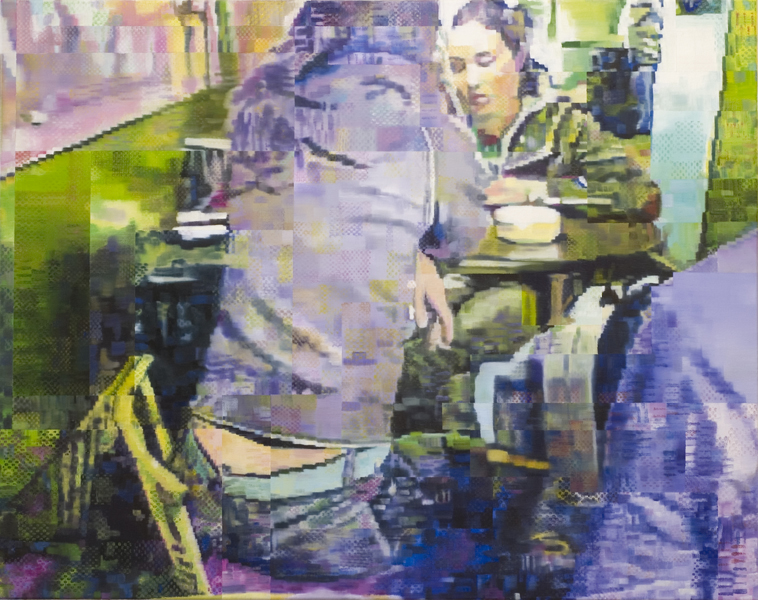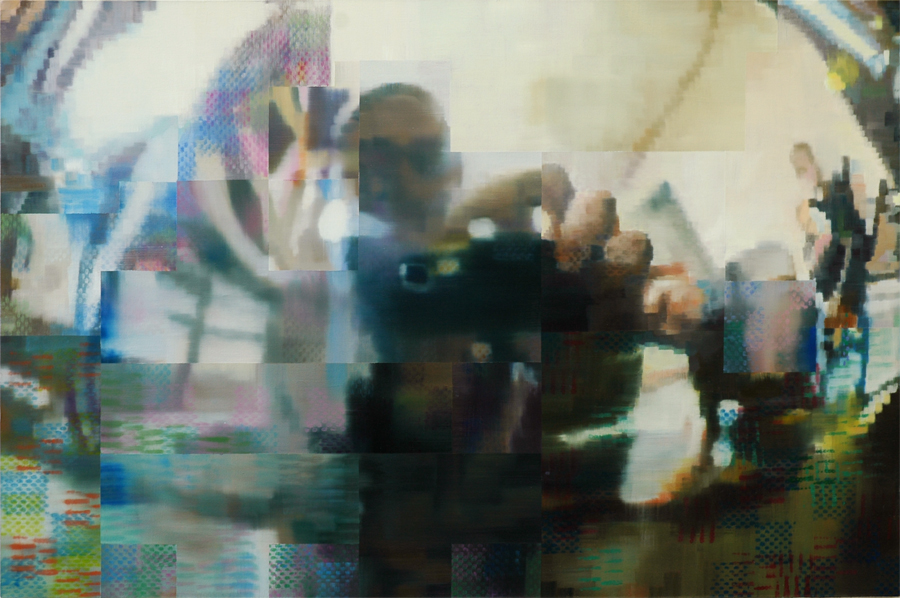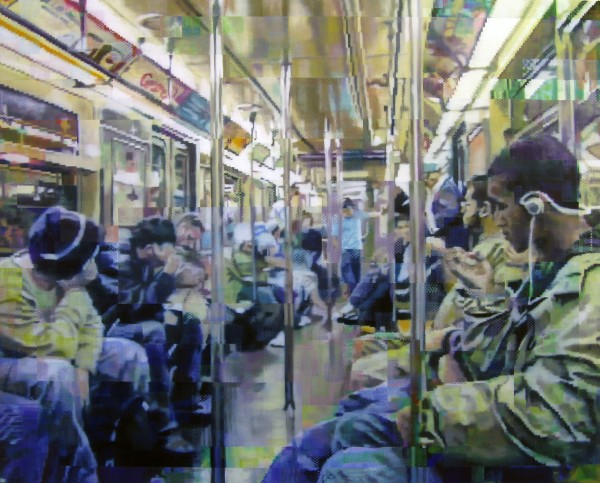Interview by by Emilio Gomariz, 2010
From TRIANGULATION BLOG, published online on 15th December 2010
http://www.triangulationblog.com/2010/12/enda-odonoghue.html


Enda O’Donoghue is an Irish artist who has been living and working in Berlin since 2002. The images in Enda O’Donoghue’s paintings all come from the Internet. They are all other people’s images, digitally found images. Searching through popular online social networks and blogs on an ongoing basis, he compulsively collects and catalogues photographs that he finds. The photos which he works with are most often the throw-away shots which otherwise gather digital dust buried away on hard-drives, camera chips, mobile phones or uploaded and then lost or forgotten someplace on the Web. With each image he paints he is meticulous about tracing the ownership and requesting permission, partly as a way of dealing with the anonymous nature of the Internet and also a reaction to the issues surrounding online privacy and copyright.
The process of painting from these images is slow and methodical, firstly dissecting the image into sections on paper. Echoing and playing with the nature digital image processing and compression algorithms, the painting process is highly analytical and methodical and yet filled with randomness and inviting of errors, misalignments and glitches. See more;
(Esp)Enda O’Donoghue es un artista irlandés que ha estado viviendo y trabajando en Berlín desde el 2002. Las imágenes de sus pinturas provienen de Internet. Son imágenes de otras personas que ha ido encontrando buscando a través de conocidas redes sociales on line y blogs de forma permanente que posteriormente recoge y cataloga. Las fotos con las que trabaja normalmente son pobres, da igual si han acumulado polvo o llevan mucho tiempo enterradas en discos duros, chips de cámaras, teléfonos móviles o en algún lugar cargado o perdidas por la web. Con cada imagen que pinta sigue un meticuloso proceso y seguimiento de la propiedad, pidiendo permiso a cada autor, en parte es una forma de hacer frente a la naturaleza anónima de Internet y también una reacción a las cuestiones relacionadas con la privacidad on line sobre los derechos de autor.
El proceso de pintura de estas imágenes es lenta y metódica, en primer lugar se realiza la disección de la imagen en secciones sobre el papel. Haciéndose eco y jugando con los algoritmos de procesamiento de la naturaleza de la imagen digital y la compresión, el proceso de pintura es muy analítico y metódico, al mismo tiempo lleno de aleatoriedad e invitando a los errores, desajustes y problemas técnicos.
Por motivos de estética del propio post (por no hacerlo inmensamente largo), he decidido trasladar la info en español fuera de este, utilizando

The following painting entitled “In the Elevator” is from 2009. The piece is 90 x 120 cm and as you can see it is painted in sections; irregular shaped interlocking generally squarish rectangularish blocky ill-fitting jigsaw puzzle or Tetris like sections. This is the general process behind all of my recent paintings and with each piece I have photographed every stage of their development so at the end I have almost a readymade animation of the build-up of the image.

The original photo was found on a photo sharing website. Like all with all my recent work the source was someone else’s photograph, found online while searching and surfing. I collect photos on an ongoing basis and categorize and catalogue them. When I find one that I wish to work with I attempt to make contact with the original photographer and request their permission to use their photo for my work. This is often met with complete surprise because I tend not to be asking for their “best” photos, in fact often they think I am asking for their worst. When each painting is completed I make a point of sending a photo of the painting back to the original photographer, and in some cases this brings the image back to its source in a way, see here.
How long have you been painting? When did you adopt that digital style or which relation do you have with it?
I really don’t know how long I have been painting, it’s something that’s always been there for me, but I guess I have been painting seriously since studying it at art college between 1995 and 1999. After that I took a break from it for a couple of years and went on to study interactive and multi-media then worked teaching and researching in the area of interactive media but I returned to painting in 2001 or 2002 I think. I have been painting from digital photographs for about 7 years and over that time developing and experimenting with various ways to deal with these images with paint.
Why do you represent digital environments with a material like oil that it isn’t?
Painting is by its very nature a slow medium and particularly with the way I make paintings, I have almost exaggerated this slowness through my working process and this is in stark contrast to the ideas of digital technology and photography which are all about speed, ease and abundance. These contrasts are maybe the best explanation for my reason to use the material of oil paint.
What’s the size of your paintings and how long it takes to finish it?
The paintings all vary in size, with the most recent work the largest was 140 x 170 cm and the smallest was 60 x 100 cm and I am currently planning some larger scale works about 200 x 250 cm or so. I have painted quite a few at a size of 120 x 150 cm and I think there is roughly about one full month of work in each of these but generally I work on two or three paintings at one time so it is always difficult to say exactly how long each takes.
Which sources do you use to find the pictures for your paintings?
All the photos that I work with are found online in various places such as Facebook, Twitter photos, various blogs and some photo sharing sites.
Do you edit the pictures before start painting?
I don’t edit the photos apart from sometimes some cropping of the image but generally I don’t do this very often. I do play with the quality of the images and by reducing the quality until glitches appear and then using this as a guide to dissecting the images.
I suppose that your first source of inspiration is the beautiful world called Internet, could you say others sources, artists, painters…?
Regarding artists and in particular painters, I have a list, a long list that keeps growing. I am constantly looking at new art and artists and visiting exhibitions. Living in Berlin offers a vast ever changing selection to be seen, much of it is terrible but within the mix there are always a few gems. But some of the consistent influences on me as a painter have been Gerhard Richter, Malcolm Morley, Richard Hamilton and David Hockney, to name but a few. Other names that come to mind are Eberhard Havekost, Xie Nanxing from China and I really like the Dutch artist Marcel van Eeden and his drawings.
A huge influence on my work has come from my own background both from studying computer programming for almost three years and also working in web design, web development, video editing, online marketing and other Internet and multi-media type work. All of that has effected not only the images that I choose and the source of these images but also has a direct influence on the way my process has developed.
It may sound crazy, but have you ever thought or have you already done any short animation with your paintings frame by frame? I think that it would just be amazing to mix the oil textures with that digital environment creating any sort of distortion or glitch effect,.. wow, It just blows my mind thinking about it! what do you think?
No I haven’t done any animations with the paintings. It might be an interesting angle. I have been looking at very glitch digital video files and the totally abstract quality to the digital noise that occurs when the video file is corrupt. There is a strange beauty to those patterns and colours.
What’s the highest achievement with your work?
I guess having a solo exhibition in New York in 2009 and also this year, 2010, some of my work was shown at the Shanghai Expo. But also over the past few years I have been co-organising and curating some group exhibitions in various empty shop spaces in Berlin with a German artist, the photographer Gergor Stephan and these projects have resulted in a couple of exhibitions which I am very proud of, in particular the most recent show which was in November 2009 and called “der Prozess”.
